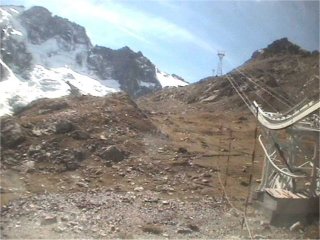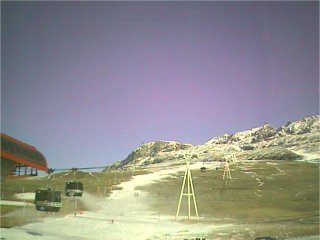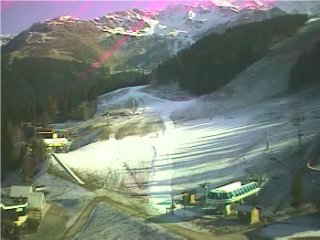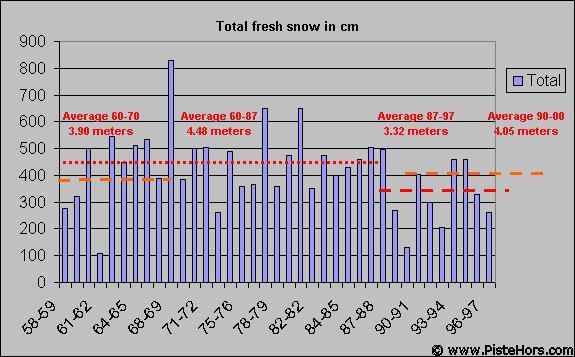
Weather > Effects of Global Warming on Skiing
The subject of global warming arouses strong emotions. For the oil lobby it is something cooked up by eco warriors bent on destroying their business, and even if climate change does exist they claim it is something entirely normal. For the green lobby global warming will heat our planet on average by 6°C in the next century, melting roads, drowning Pacific islands and destroying the delicate balance of the eco system. Whatever the causes, the ski industry is extremely concerned about the affects climate change will have on its business.
Following the little ice-age that lasted from 1550 to around the start of the industrial revolution in 1850 scientists started to speculate on a warming of the climate. in 1896 Swedish scientist Svante Arrhenius published a groundbreaking paper on the contribution industrial emissions from the burning of fossil fuels make to global temperatures. The greenhouse effect was born. Arrhenius had speculated that the ice-ages were caused when global CO2 levels fell for some reason and predicted that temperatures would continue to rise during the 20th century. He thought this would be positive. In the 1906 French Alpine Club annual David Martin, a botanist and resident of Gap published an article "Are these indications of a coming change in climate?". He had noticed an extension of the lichen Balea Geographicai on the granite rocks of the Pelvoux range and an increase in the flora on the terminal moraines in the rest of the Alps.
Even disaster scenarios involving the greenhouse affect, with trapped heat slowly stewing the planet, are not a new. In popular culture, Harry Harrison's book Make Room! Make Room! (Amazon-UK:0140026649) written in 1965 (later turned into the iconic film Soylent Green - Amazon:B00009NHBM or Amazon-UK:B0000AISK8), postulated an overpopulated New York of 2022 ravaged by global warming. The heat is unbearable, there are food and water shortages and the majority of the population lives in misery. But even much smaller changes than this apocalyptic vision can have quite dramatic affects on snowfall. The weather patterns in France are controlled by the mountain ranges to the east and south of the country. Normally the air currents that bring snowfall in the Alps arrive from the West and this is especially true for the Northern Alps. High pressure out to the Atlantic, the so called Azores high can send the snow laden depressions scurrying to the south or north. Too far to the south, over the Mediterranean and the moist air can double back over Italy, given them a bumper season. But the high frontier ridges act as a barrier to these weather fronts.
After the boom years of the 70s and 80s the first sign that things were changing came during the Christmas of 1988. There was a distinct lack of snow over the holiday period but there had been worse starts to the season. In January everyone was waiting for the situation to improve as it had done the year before. But the barometer remained obstinately stuck between 1035 and 1040 millibars, values normally associated with the fine summer months. Any snow seemed like a miracle from above. There were just two falls, of modest proportions, during the whole of January 1989. It was between 1500 and 1800 meters that the situation was really precarious. No more than 10cm at Autrans and 15cm at the bottom of the pistes of Megève. North Faces were still practical, especially for ski tourists but south facing slopes saw quite different activities for winter, mountain biking across fields of violets many months early. In the Southern Alps things were even worse. Between 3000 to 4000 seasonal workers were unemployed in the Hautes Alpes region alone, even though the ski resort of Vars had come up with a new way to get snow to the pistes, by helicopter. Everyone was worried about the snow drought, especially with the big February holiday period not far off.

La Grave at 2400 meters, mid December 2001
The media started to stir things up, so much so that the Arèches ski station had to get its snowfall figures authenticated by a Judge. The Ministry of Tourism agreed to pay the workers in some resorts that were particularly badly affected. The weather forecasters of the Meteorological Office fielded non-stop questions but they could only reply with the statistics that showed great variations in the level of snowfall and that 'droughts' rarely lasted a whole season. They were not wrong, at the end of February the snow began to fall, a bit late for the holidays but enough to get the season, and the avalanches, underway.

l'Alpe d'Huez, 18th December 2001
The following season was awaited with a certain trepidation by those professionals who make their living from snow. Their worries were justified, between the 1st of December 1989 and the 25th January 1990 not a single flake fell below the 1700 - 2000 meter level. Most ski resorts had trouble operating, even those at altitude. On the 20th January there was less than 10cm of snow at the bottom of the pistes at l'Alpe d'Huez, la Plagne, Val d'Isère and Isola 2000. The statistics showed the last time something similar had occurred was in 1964, a time when a lack of snow would not have had the same consequences.
At the start of 1990 skiing was only possible above 2000 meters and then only on north facing slopes. But off-piste was not without risks, especially avalanches. At altitude the snow pack, where it existed at all, was very unstable as some ski mountaineers found to their cost.
The snow conditions didn't really improve until mid-February after a storm that lasted four days and that would go down in history. Thousands of holiday makers were trapped for a couple of days in the Tarentaise valley. But the storm didn't help everywhere because, below 1500 meters, it was followed by rain. And the storm didn't really touch the Southern Alps. To summarize, the season could best be described as a total disaster!
After two terrible seasons the only thing that could be said is that more recently snow levels have seen highs and lows without a return to the bounty years of the 70s or the early 80s. The season of 92-93 was, quite frankly, mediocre despite huge quantities of snow at altitude during the autumn (note: it was this snowfall that caused an avalanche onto the Beranger piste at Val Thorens that killed 5 skiers in November 92). 95 was more satisfactory with good snow from the middle of January and 94 was also a good vintage with an excellent, wintry April.
In 95-96, we had to wait until February to be able to ski properly in the Northern Alps whereas in the South there was ample snow. In 96-97 season there was an almost unique situation, skiing almost the whole season on snow that fell in the 15 days at the end of November with sunshine throughout February, March and April. This sunshine caused a phenomena that is normally associated with tropical regions, the formation of strange stalagmite shapes called pénitents. 97-98 once again saw snow in the Autumn, warming then drought in the Northern Alps and abundance in the South. A situation which caused a very unstable snow pack. But then 98-99 was really exceptional. Huge snowfalls during February in the Northern Alps, Switzerland and Austria. Avalanches ripped through the villages of Montroc near Chamonix and Galtur in Austria. The depth of snow was described as a 500 year event by researchers Davos?. 00-01 and 01-02 were both mediocre seasons, with the exception of the Pyrenees which in 2002 saw the best snow for a decade. 2002-03 was said to be the return of a 'real winter' but excellent snow and visitors in the important February holiday period masked a poor Christmas with rain and green fields and a period of warm spring weather lasting from February to April and then a blazing heat-wave in July and August that left glaciers bare, hardly a return to 'normal'.

Les Sept Laux in mid-December 2001
In summary the last fifteen years has seen the best and worst of times, at least with regard to snow levels. Below a certain altitude, around 1300 to 1500 meters and especially in the Northern Alps there is one certainty. What was, between 1960 and and 1988, considered an exceptionally poor season has become the norm (see graphic).

Total fresh snow in centimetres at 945 meters in the Chartreuse
Next Section: Climate Change and Skiing
<< Snow - Avalanche Conditions | Weather | French Ski Resort Average Snow Depths >>